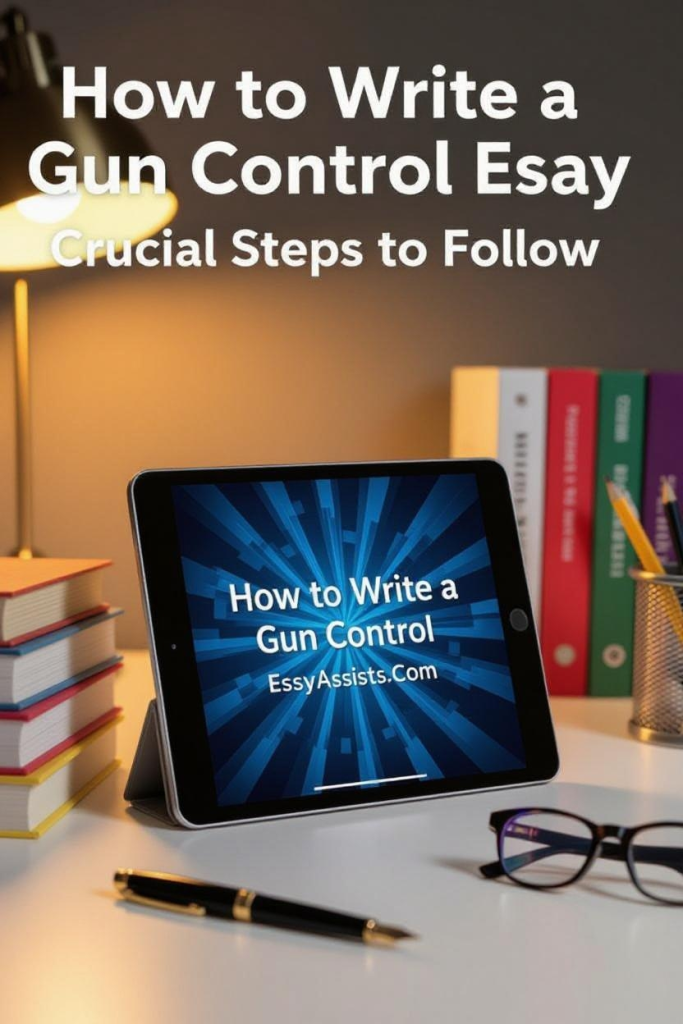
Updated October 2025
Writing a gun control essay can be a challenging task, especially since the topic touches on personal beliefs, politics, and public safety. Whether you’re a high school, college, or university student, learning how to write a gun control essay that is persuasive, factual, and well-structured will set you apart academically.
In this comprehensive guide, we’ll walk you through the essential steps for writing a gun control essay that impresses your professor and engages your readers — from research to final editing. Visit Essayassists.com today for affordable, reliable writing help!
Here’s a full and polished section for your blog under the heading:
Step 1: Understand What Type of Essay You’re Writing
Before diving into research or drafting, it’s crucial to identify what kind of essay you are required to write. Gun control is a complex and controversial topic that can be explored from many angles — legal, ethical, political, or social. Understanding your essay type helps you determine your tone, structure, and argument style.
Here are the main types of essays you might write on gun control:
1. Argumentative Essay
An argumentative essay requires you to take a clear stance and defend it using facts, statistics, and credible research. You must also address counterarguments and explain why your position is stronger.
Example:
“Stricter gun control laws are necessary to reduce firearm-related deaths in the United States.”
2. Persuasive Essay
A persuasive essay focuses on convincing the reader to accept your opinion. It often uses emotional appeal alongside logic, though maintaining professionalism is key.
Example:
“Every citizen should support stronger gun control laws to make communities safer.”
3. Expository Essay
An expository essay is more neutral — it presents both sides of the issue without bias. Your goal is to inform, not persuade.
Example:
“This essay examines how different countries implement gun control and the outcomes of those policies.”
4. Analytical Essay
An analytical essay breaks down a specific aspect of gun control — such as legislation, crime data, or public opinion — and examines its components in detail.
Example:
“Analyzing the effectiveness of background checks in preventing firearm-related crimes.”
✅ Tip: Before writing, review your assignment instructions carefully. If your professor hasn’t specified a type, choose one that fits your interests and the available research. Understanding the essay type early will help you organize your thoughts and write more effectively.
Step 2: Choose a Specific Topic

Once you understand the type of essay you’re writing, the next crucial step is to narrow down your topic. “Gun control” is a broad and often controversial subject — writing about it generally can make your essay sound vague or repetitive. Instead, selecting a focused and manageable topic helps you craft a strong argument and keep your essay organized.
Start by thinking about the angle you want to explore. Are you focusing on the legal, social, or ethical side of gun control? Do you want to examine causes, effects, or solutions? A clear topic helps your readers understand your purpose right from the start.
Here are a few specific gun control essay topic ideas you can consider:
🎯 Argumentative Essay Topics
- Should the U.S. government impose stricter background checks for gun purchases?
- Does gun ownership truly make citizens safer?
- Should assault weapons be banned for civilian use?
- Is gun control an effective way to reduce crime rates?
📚 Expository or Analytical Essay Topics
- The impact of gun control laws on public safety in different states.
- Comparing gun control laws in the U.S. and other developed countries.
- How mental health policies intersect with firearm regulations.
- The relationship between gun availability and homicide rates.
💬 Persuasive Essay Topics
- Why mandatory gun safety training should be required for all gun owners.
- How better gun storage laws can prevent accidental shootings.
- The role of education in reducing gun-related violence.
- Why society should balance gun rights with public safety concerns.
✅ Tip: When choosing your topic, make sure:
- You can find reliable sources (government data, peer-reviewed studies, or credible news outlets).
- The topic is specific enough to cover thoroughly in your word count.
- It’s interesting to both you and your intended audience — your passion will show in
Step 3: Conduct Thorough Research

Research is the backbone of any strong gun control essay. Good research tells the story beyond opinions — it gives you facts, context, credible experts, and the evidence you’ll use to build your argument. Below is a clear, practical playbook you can follow right now.
1) Start with high-quality sources
Prioritize primary and reputable secondary sources:
- Government data & reports: CDC (mortality & injury data), FBI (Uniform Crime Reports), Bureau of Justice Statistics.
- Peer-reviewed journals: criminology, public health, law reviews (use Google Scholar, JSTOR, PubMed).
- Think tanks & research orgs (use cautiously): Pew Research Center, RAND, Brookings — check for methodology and bias.
- Court rulings & statutes: read text of laws and major Second Amendment cases when relevant.
- Reliable news outlets for recent events — prefer reporting that cites official sources or experts.
2) Use smart search queries (examples you can paste)
"firearm-related deaths 2023 CDC data""background checks effectiveness study 2019 2020 site:.gov""assault weapon bans crime rates comparison study""Second Amendment Supreme Court ruling full text 2008 2022"
These get you more focused, trustworthy results than a generic “gun control statistics” search.
3) Evaluate every source quickly
Ask: who produced it? why? when? how strong is the evidence?
- Authority: author credentials, institution, peer review.
- Accuracy: are methods described? are data sources transparent?
- Recency: prefer the latest reliable data (but older foundational studies can still be valid).
- Bias: notice advocacy language; if a group has a clear agenda, triangulate with neutral sources.
- Methodology: for studies, check sample size, controls, statistical significance.
4) Collect primary evidence and case studies
Primary items make essays persuasive:
- Exact statistics (with year and source) — e.g., “CDC: X firearm deaths in 2022.”
- Quotes from experts, judges, or policymakers (include full citation).
- Text from key laws (state statutes, federal statutes, court opinions).
- Real-world examples (policy changes and measurable outcomes — Australia 1996, state-level laws in the U.S., etc.).
5) Take organized notes & track citations
- Save full citation details (author, title, org, date, URL, page numbers).
- Use a citation manager (Zotero, Mendeley) or a simple spreadsheet with columns: Source, Key claim, Evidence, Quote, Use in essay (which paragraph).
- Annotate why you’ll use each source — eg. “supports thesis point 2” or “used to rebut claim X.”
6) Triangulate and cross-check facts
Don’t rely on a single study or article for major claims:
- If one paper claims an effect, look for follow-ups, meta-analyses, or critiques.
- For statistics, find the original dataset (not just an article that cites it).
- When studies disagree, report both findings and explain differences (time period, methods)
7) Beware of common pitfalls
- Cherry-picking: don’t pick only studies that support your view — address contradicting evidence.
- Misreading correlation as causation: many gun-control debates hinge on causal claims; treat causality carefully.
- Outdated stats: always include the year of a statistic. Recent trends matter.
8) Keep ethics and sensitivity in mind
Gun control is emotionally charged. When using case examples (shootings, victims), be respectful: avoid sensational language and prioritize accuracy.
9) Prepare your research for writing
- Build a short annotated bibliography (3–10 core sources) you’ll cite repeatedly.
- Draft one-sentence notes for each source: the claim it supports and where you’ll place it in your outline.
- Save PDFs or screenshots of key tables/figures you might quote or recreate.
Quick research checklist (tick off as you go)
- Found at least 3 peer-reviewed articles or government datasets relevant to my thesis
- Saved full citation info for every source I plan to use
- Collected at least one primary source (law, court opinion, dataset)
- Noted any major studies that conflict with my thesis and saved responses/rebuttals
- Organized notes into which paragraph/claim each source will support
Step 4: Craft a Strong Thesis Statement

Your thesis statement is the heart of your gun control essay — it defines your main argument and tells the reader exactly what to expect. A strong thesis gives your essay purpose, direction, and focus. Without it, your writing can become vague or unfocused.
Think of the thesis as your essay’s compass: every paragraph you write should point back to it.
What Is a Thesis Statement?
A thesis statement is usually one or two sentences at the end of your introduction that clearly presents your stance or the central idea of your essay. It should answer this key question:
“What am I trying to prove or explain about gun control?”
Your thesis should be:
- Clear: Avoid vague language or generalizations.
- Specific: Focus on one main argument or perspective.
- Debatable: Present an idea that others might challenge.
- Focused: Avoid covering too many issues in one sentence.
How to Write an Effective Gun Control Thesis Statement
- Start with your main opinion or finding.
Decide what position you want to take — for, against, or neutral on gun control. - Add your reasoning.
Briefly explain why you hold that view or how you’ll support it. - Avoid filler or vague phrases.
Stay away from “In this essay, I will discuss…” Instead, make a strong declarative statement. - Ensure it matches your essay type.
- Argumentative → takes a clear side.
- Persuasive → encourages readers to agree.
- Expository → remains neutral and informative.
Examples of Gun Control Thesis Statements
For Stricter Gun Control
- “Stricter gun control laws are essential to reduce firearm-related deaths and prevent mass shootings.”
- “Mandatory background checks and waiting periods can significantly reduce the risk of guns falling into the wrong hands.”
Against Stricter Gun Control
- “Tighter gun restrictions infringe upon constitutional rights and fail to address the root causes of crime.”
- “Law-abiding citizens should not be penalized for owning firearms due to the actions of criminals.”
Balanced or Analytical View
- “Effective gun control policies require balancing individual rights with public safety through improved background checks and education.”
- “While gun ownership is a constitutional right, better enforcement of existing laws could reduce misuse without restricting freedom.”
✅ Quick Tips for a Powerful Thesis
- Keep it one or two sentences long — short but impactful.
- Avoid emotional or exaggerated language.
- Make sure every argument in your body paragraphs supports your thesis.
- Revise it after writing your first draft — your thesis often becomes clearer as your essay develops.
Example in Context
Weak Thesis:
“Gun control is a big issue in the United States.”
Why it’s weak: It’s too broad and doesn’t present an argument.
Strong Thesis:
“Comprehensive gun control policies that include universal background checks and mental health assessments can reduce gun violence without violating citizens’ rights.”
Why it’s strong: It’s clear, specific, and debatable.
A well-written thesis statement sets the tone for your entire essay. Once you have it, writing the rest of your paper becomes much easier — every paragraph will work together to support your central claim.
Would you like me to move on to Step 5: Organize Your Essay with a Logical Outline next, keeping the same SEO blog tone and formatting?
Your thesis is the foundation of your essay — it defines your main argument or purpose. Keep it clear, concise, and specific.
Examples:
- “Stricter gun control laws are essential to reduce firearm-related deaths and enhance public safety.”
- “The right to bear arms must be preserved as a fundamental constitutional freedom.”
- “A balanced approach to gun regulation, focusing on background checks and education, can effectively prevent violence without infringing on rights.”
post:
Step 5: Organize Your Essay with a Logical Outline

Once you’ve crafted a strong thesis statement, the next step is to organize your essay using a clear and logical structure. A well-structured outline helps your ideas flow naturally, ensures balance, and keeps your writing focused on your main argument.
Think of your outline as the blueprint of your essay — it shows where every argument, example, and piece of evidence belongs.
Why an Outline Matters
A logical outline allows you to:
- Present ideas in a coherent order.
- Avoid repetition or confusion.
- Ensure that each paragraph supports your thesis.
- Save time during the writing and editing process.
By planning your structure before you start writing, you’ll produce a more persuasive and polished essay.
Standard Structure for a Gun Control Essay
Most essays follow the five-paragraph structure, but you can adjust it depending on your word count or complexity.
1. Introduction
Your introduction sets the tone for your essay and grabs the reader’s attention.
Include the following:
- Hook: Start with a surprising statistic, quote, or question.
Example: “Every year, over 40,000 Americans die from gun-related injuries — a number that continues to rise despite ongoing debates about firearm laws.”
- Background Information: Briefly explain why gun control is a relevant issue.
- Thesis Statement: Present your main argument or perspective.
✅ Tip: Keep your introduction concise — around 10% of your essay length.
2. Body Paragraphs
Your essay body should contain three to five paragraphs, each focused on a single main idea that supports your thesis.
Each paragraph should include:
- Topic Sentence: Introduces the paragraph’s key point.
- Evidence and Examples: Use statistics, studies, expert opinions, or real-world cases.
- Analysis: Explain how the evidence supports your argument.
- Transition: Smoothly link to the next paragraph.
Example Body Paragraph Outline
Paragraph 1: Background checks and their impact on gun violence.
Paragraph 2: The role of mental health in gun ownership laws.
Paragraph 3: Counterarguments — address opposing views respectfully and logically refute them.
✅ Tip: Always connect your evidence back to your thesis. Every paragraph should move your argument forward
3. Counterarguments Section (Optional but Powerful)
Including a counterargument paragraph shows that you’ve researched multiple perspectives. Acknowledge opposing views, then explain why your stance is stronger.
Example: “Some argue that stricter gun laws violate constitutional rights; however, research shows that reasonable regulations can enhance public safety without infringing on freedom.”
4. Conclusion
Your conclusion should leave a lasting impression and reinforce your central argument.
Include:
- Restated Thesis: Rephrase your main argument in new words.
- Summary of Key Points: Briefly revisit your main ideas.
- Final Thought: End with a strong statement, question, or call to action.
Example: “Balancing the right to bear arms with public safety isn’t simple, but with evidence-based policies and responsible ownership, a safer future is possible.”
✅ Tip: Avoid introducing new information in your conclusion. Focus on wrapping up your essay effectively.
Sample Gun Control Essay Outline
I. Introduction
- Hook: startling fact or quote about gun violence
- Background context
- Thesis statement
II. Body Paragraph 1
- Topic sentence
- Supporting evidence (statistics, studies)
- Analysis
III. Body Paragraph 2
- Topic sentence
- Evidence and examples
- Connection to thesis
IV. Body Paragraph 3 (Counterargument)
- Opposing view
- Evidence
- Rebuttal
V. Conclusion
- Restate thesis
- Summarize key ideas
- End with a memorable insight or call to action
A clear outline helps you stay focused, write faster, and maintain a logical flow from start to finish. When your essay is well-organized, your reader can easily follow your reasoning — which strengthens your credibility and persuasive power.
Step 6: Use Evidence, Not Emotion

Gun control is one of the most debated and emotionally charged topics in modern society. When writing your essay, it’s easy to let passion take over — but strong academic writing relies on facts, logic, and credible evidence, not personal feelings or emotional language.
A convincing gun control essay shows your ability to think critically, analyze data, and present arguments supported by research. Let’s explore how to achieve that.
1. Prioritize Facts Over Feelings
Avoid emotional or subjective statements like:
“It’s obvious that guns are evil.”
“Anyone against gun control doesn’t care about safety.”
Instead, use data and expert opinions to back your claims:
“According to the Centers for Disease Control and Prevention (CDC), firearm-related deaths increased by X% in 2023, suggesting the need for stronger preventive measures.”
Facts speak louder than emotions — and they make your writing credible and persuasive.
2. Use Reliable Data Sources
Support every major claim with verifiable evidence. Reputable sources include:
- Government agencies: CDC, FBI, Bureau of Alcohol, Tobacco, Firearms and Explosives (ATF)
- Research organizations: Pew Research Center, RAND Corporation, National Institute of Justice
- Academic journals: Journal of Public Health Policy, American Journal of Preventive Medicine, Criminology & Public Policy
- Court cases and legal databases: when discussing constitutional arguments
Always verify that your data is current, accurate, and relevant to your topic.
3. Cite Expert Opinions
Quoting experts strengthens your argument while showing you’ve engaged with scholarly perspectives.
Example:
“Criminologist Daniel Webster from Johns Hopkins University argues that universal background checks could reduce firearm homicides by up to 40%.”
Expert commentary adds authority and depth to your essay.
4. Avoid Loaded or Biased Language
Your tone should remain neutral and academic, even if you hold a strong opinion. Replace emotional or judgmental language with objective terms.
| Emotional Language | Neutral, Academic Language |
| “Gun owners are reckless.” | “Some studies suggest that inadequate firearm storage contributes to accidental shootings.” |
| “Gun control destroys freedom.” | “Opponents of stricter gun laws argue that such policies may limit individual freedoms.” |
| “Guns are the main cause of crime.” | “Firearms are one of several factors associated with violent crime rates.” |
Using calm, precise language helps your essay sound professional and credible.
5. Balance Both Sides
Even if your stance is clear, acknowledge opposing viewpoints with respect and respond to them logically.
“While gun rights advocates emphasize personal protection, evidence suggests that background checks and waiting periods can prevent impulsive acts of violence.”
This balanced approach demonstrates critical thinking — a key element in academic writing.
6. Integrate Statistics Smoothly
Don’t just list numbers — explain what they mean. For example:
“In 2022, the U.S. recorded over 48,000 firearm-related deaths. This figure, up nearly 20% from 2018, highlights the urgent need for consistent federal policies.”
Analysis gives your data context and impact.
7. Reference and Cite Properly
Every fact, statistic, or expert quote must be properly cited in APA, MLA, or Chicago style, depending on your assignment. This not only avoids plagiarism but also boosts your essay’s credibility.
✅ Tip: If you’re using online data, include the organization’s name and publication year, e.g., (CDC, 2024).
In Summary
Relying on evidence rather than emotion transforms your gun control essay from an opinion piece into a well-reasoned academic argument. When you use facts, statistics, and expert insights — and present them with clarity and fairness — your essay becomes more persuasive, objective, and powerful.
“Emotion engages readers, but evidence convinces them.”
Step 7: Revise, Edit, and Proofread
Once your first draft is complete, take time to refine it.
- Eliminate grammar and punctuation errors.
- Ensure paragraphs transition smoothly.
- Double-check citations (APA, MLA, or Chicago).
- Read your essay aloud to catch awkward phrasing.
You can also use professional editing tools or essay writing services like Essayassists.com to polish your final draft before submission.
Step 8: Add a Balanced Perspective
Even if you strongly support one side, acknowledging the opposing viewpoint shows maturity and depth in your analysis. For example:
“While gun rights advocates stress the importance of self-defense, stricter background checks could prevent weapons from falling into the wrong hands.”
Balance makes your essay more persuasive and credible.
Example Gun Control Essay Topics
Need some inspiration? Try these:
- Should gun ownership be limited by mental health evaluations?
- The effectiveness of gun-free zones in reducing crime
- Gun control in America vs. other developed nations
- Technology and gun safety: smart guns and background databases
- How gun laws affect school safety
Final Thoughts
Writing a gun control essay requires patience, objectivity, and solid research. It’s not just about choosing a side—it’s about constructing a logical, fact-based argument that informs and persuades readers.
By following these crucial steps—choosing a focused topic, building a strong thesis, backing it with evidence, and presenting it clearly—you’ll be able to craft a gun control essay that stands out academically and engages your audience effectively.
Need Professional Help Writing Your Gun Control Essay?
If you’re short on time or struggling to structure your ideas, Essayassists.com offers professional writing help for all types of essays — including argumentative, persuasive, and analytical essays on gun control. Our expert writers ensure high-quality, plagiarism-free papers tailored to your academic level.
📘 Visit Essayassists.com to get your essay written today!
Frequently Asked Questions (FAQs) about Writing a Gun Control Essay

1. What is the main purpose of a gun control essay?
The main purpose of a gun control essay is to analyze, explain, or argue a position about firearm ownership, legislation, or public safety. Depending on your essay type (argumentative, persuasive, or expository), you may aim to inform readers, present balanced views, or persuade them to support your stance.
2. How do I choose a good topic for a gun control essay?
Select a specific and focused topic rather than a broad one. For example, instead of “Gun control in the U.S.,” narrow it down to “The impact of universal background checks on gun violence” or “Should teachers be allowed to carry firearms in schools?”
A narrow topic helps you build stronger arguments and find relevant research.
3. What are reliable sources for gun control research?
Use credible and verifiable sources, such as:
- Government databases (CDC, FBI, Bureau of Justice Statistics)
- Peer-reviewed journals and university studies
- Research centers (Pew Research, RAND, Brookings)
- Court rulings and constitutional analyses
Avoid blogs, opinion-based articles, or politically biased sources unless you’re analyzing them critically.
4. How long should my gun control essay be?
Essay length depends on your assignment. Typically:
- High school essays: 800–1,200 words
- College essays: 1,500–2,500 words
- Research papers: 3,000 words or more
Focus on quality over quantity—make sure every paragraph adds value to your argument.
5. What should my thesis statement include?
A strong thesis should clearly express your main argument and reasoning in one or two sentences.
Example:
“Stricter gun control laws that include universal background checks and mental health evaluations can reduce firearm deaths while protecting citizens’ rights.”
Your thesis should be specific, debatable, and supported throughout the essay.
6. Should I include counterarguments in my essay?
Yes! Acknowledging opposing viewpoints shows that you understand multiple sides of the issue. Address counterarguments respectfully, then use facts and logic to explain why your stance is stronger. This strengthens your credibility and persuasiveness.
7. How can I make my essay sound more professional?
- Use formal, academic language (avoid slang or emotional phrases).
- Support every claim with data or expert sources.
- Structure your essay with clear headings and transitions.
- Proofread for grammar, punctuation, and citation accuracy.
- Follow the required format (APA, MLA, or Chicago).
8. Where can I get help writing my gun control essay?
If you need expert assistance with research, structure, or editing, you can rely on Essayassists.com. Our professional writers craft high-quality, plagiarism-free essays tailored to your topic, deadline, and academic level.
📘 Visit Essayassists.com today for affordable, reliable writing help!
